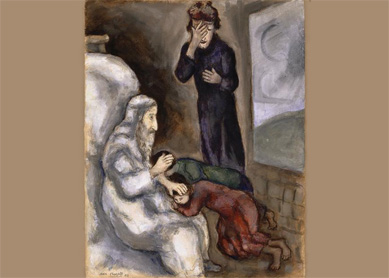By the time we journey with Jacob to the Jabbok in Gen 32, we have borne witness to an unfolding drama involving Abraham, Isaac, and Jacob. The stories about these patriarchs intertwine family conflict, deception, and unscrupulous behavior, alongside the repeated promises of God to make of Israel a great nation. Among the patriarchs, none appears more crooked than Jacob. Aptly living up to a name which means “deceiver,” “usurper,” “heel-grabber,” or “crooked,” by the time Jacob arrives at the Jabbok River, he has swindled his brother Esau out of both birthright and fatherly blessing (Gen 25:29-34; Gen 27:1-40). On the way to meet Esau for the first time in twenty years, Jacob has a strange encounter at night by the Jabbok River.
Leading Question: Who Does Jacob Encounter?
In just ten verses, Gen 32:22-32 raises a number of questions. Among them, none has proven more intriguing than the identity of Jacob’s attacker. Referred to as a “man” by the narrator (Gen 32:24-25, Gen 32:28) but recognized by Jacob as Elohim (“God,” “a divine being”) (Gen 32:30), the figure is also referred to as an “angel” in other biblical traditions (Hos 12:2-4). The narrative itself raises one final possibility—a supernatural visitation of Esau prior to their encounter the next morning (Gen 33:10). Commentators have offered many possibilities for the assailant’s identity and, among some Christian interpreters, an assertion of the preincarnate Christ. Like the identity of Jacob’s attacker, the story itself can be interpreted in diverse ways.
Leading Question: What is the Purpose of the Story?
Every biblical story we read performs some kind of work for the community who produced it and received it. Biblical stories are written to answer some question, explain some reality, or grapple with some theological truth. Therefore, biblical stories function on more than one level.
On one level, the work of the Jabbok story is political. Jacob’s name is changed to Israel, meaning “to struggle with God.” The story functions as a kind of folktale, as generation after generation recount how the nation gets its name. The realities of political rivalry between two brothers and the nations they represent, Israel and Edom, also simmer below the narrative surface, with Esau and his descendants cast as unworthy and expendable (Gen 25:19-24; Gen 26:34-35; Gen 27:1-46; Gen 28:6-9; Gen 32:1-31; Gen 33:1-17; Gen 36:1-43; Num 20:14-21; Mal 1:4; Ps 137:7; Lam 4:21-22; Rom 9:13). On another level, Jacob’s story is about exile and return, a reality experienced by the Israelies during their exile to Babylon in the sixth century BCE and their troubled return back to the land. Jacob’s story provides one way that the Israelites worked out in narrative form the existential angst wrought by this national crisis. Finally, because all biblical stories are ultimately about God, the Jabbok story also works on a theological level. Jacob comes face to face with a God who both wounds and blesses, surely representative of Israel’s own understanding and experiennce with God.
Beyond its immediate historical context, the Jabbok story continues to speak to generations of faithful people. The story testifies that all of life is lived with God—in places where we are home and reconciled with those we love—and in places of exile and pain. While Jacob is a mirror for human brokenness, the story nevertheless depicts God not as a disinterested bystander but as One faithful to covenant.



